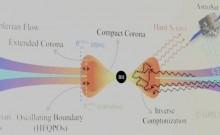
Scientists have discovered a new species of three-horned dinosaur from fossils dating back 66 to 80 million years.
Researchers have named the species as Judiceratops, a distant cousin of Triceratops and Torosaurus. The fossils were found in Judith River Formation of Hill County, Montana.
Following an analysis of the fossils, scientists said the giant creature had three horns with one small being at the nose hilt and the other two at the brow. It had frills around its head either to attract mates or as a defence mechanism.
Nicholas Longrich, a postdoctoral researcher at Yale, said in a statement, "We keep finding new species, because cerotopsids - horned dinosaurs - evolved so rapidly."
"These species show up for just a couple million years, or even a far shorter time, before another species replaces it. As you move up into younger rocks or down into older rocks, you get new species and no longer see the old ones. There was a lot of turnover."
Judiceratops, a member of the horned chasmosaurine group, had existed in the late Cretaceous era, which dated 78 million years ago.
The giant creature with its "bold, conspicuous display structures" or frills lived on low vegetations growing in the plains like ferns and other small plants.
According to scientists, the species is the oldest of the horned group of dinosaurs to have been discovered.
The discovery was published in the Bulletin of the Peabody Museum of Natural History.















